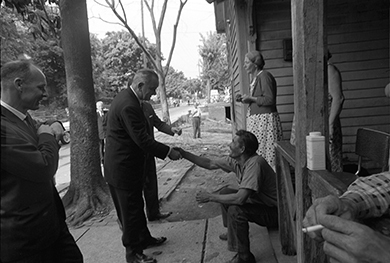| << Chapter < Page | Chapter >> Page > |
In 1965, the Johnson administration also encouraged Congress to pass the Immigration and Nationality Act, which essentially overturned legislation from the 1920s that had favored immigrants from western and northern Europe over those from eastern and southern Europe. The law lifted severe restrictions on immigration from Asia and gave preference to immigrants with family ties in the United States and immigrants with desirable skills. Although the measure seemed less significant than many of the other legislative victories of the Johnson administration at the time, it opened the door for a new era in immigration and made possible the formation of Asian and Latin American immigrant communities in the following decades.
While these laws touched on important aspects of the Great Society, the centerpiece of Johnson’s plan was the eradication of poverty in the United States. The war on poverty , as he termed it, was fought on many fronts. The 1965 Housing and Urban Development Act offered grants to improve city housing and subsidized rents for the poor. The Model Cities program likewise provided money for urban development projects and the building of public housing.
The Economic Opportunity Act (EOA) of 1964 established and funded a variety of programs to assist the poor in finding jobs. The Office of Economic Opportunity (OEO), first administered by President Kennedy’s brother-in-law Sargent Shriver, coordinated programs such as the Jobs Corps and the Neighborhood Youth Corps, which provided job training programs and work experience for the disadvantaged. Volunteers in Service to America recruited people to offer educational programs and other community services in poor areas, just as the Peace Corps did abroad. The Community Action Program, also under the OEO, funded local Community Action Agencies, organizations created and managed by residents of disadvantaged communities to improve their own lives and those of their neighbors. The Head Start program, intended to prepare low-income children for elementary school, was also under the OEO until it was transferred to Department of Health, Education, and Welfare in 1969.
The EOA fought rural poverty by providing low-interest loans to those wishing to improve their farms or start businesses ( [link] ). EOA funds were also used to provide housing and education for migrant farm workers. Other legislation created jobs in Appalachia, one of the poorest regions in the United States, and brought programs to Indian reservations. One of EOA’s successes was the Rough Rock Demonstration School on the Navajo Reservation that, while respecting Navajo traditions and culture, also trained people for careers and jobs outside the reservation.

The Johnson administration, realizing the nation’s elderly were among its poorest and most disadvantaged citizens, passed the Social Security Act of 1965. The most profound change made by this act was the creation of Medicare, a program to pay the medical expenses of those over sixty-five. Although opposed by the American Medical Association, which feared the creation of a national healthcare system, the new program was supported by most citizens because it would benefit all social classes, not just the poor. The act and subsequent amendments to it also provided coverage for self-employed people in certain occupations and expanded the number of disabled who qualified for benefits. The following year, the Medicaid program allotted federal funds to pay for medical care for the poor.

Notification Switch
Would you like to follow the 'U.s. history' conversation and receive update notifications?